Key takeaways:
- Cannabis edibles offer a unique method for pain relief with prolonged effects compared to smoking.
- Starting with a low dosage and practicing patience is crucial due to varying individual reactions to edibles.
- Personal experiences with edibles can differ significantly; it’s important to know your limits and learn from trial and error.
- Exploring alternative pain management methods, such as mindfulness and acupuncture, can complement the use of edibles.
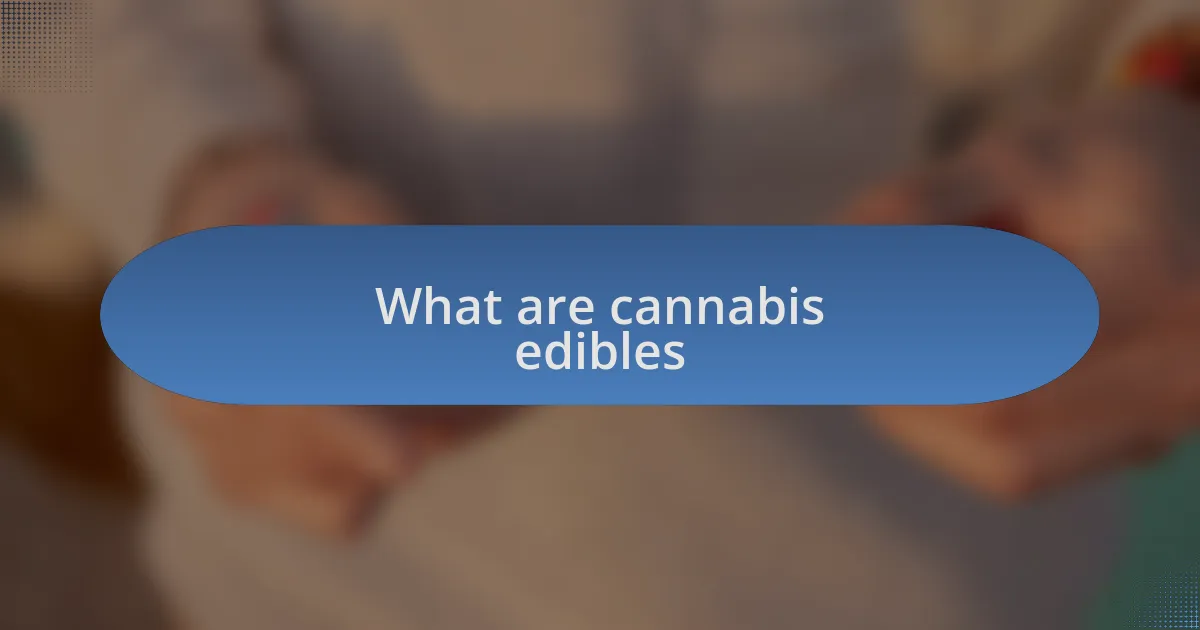
What are cannabis edibles
Cannabis edibles are food products infused with cannabis extracts or oils, offering a unique way to experience the effects of the plant. I remember trying an infused brownie for the first time; the anticipation was almost palpable. How could something so delicious hold such potential for relief?
These edibles come in various forms, from gummies to drinks, and they allow for a more prolonged experience compared to smoking or vaping. When I first learned about the difference in onset time, it felt both exciting and daunting. Waiting for the effects to kick in required patience, but the gentle wave of relief that followed was well worth it.
One thing to keep in mind is that the potency can vary significantly between products, making it essential to start with a low dose. The first time I ventured into this world, I underestimated this. It taught me the importance of mindfulness and respect for the plant. Have you ever felt the need to slow down and savor something extraordinary? That’s the essence of cannabis edibles.
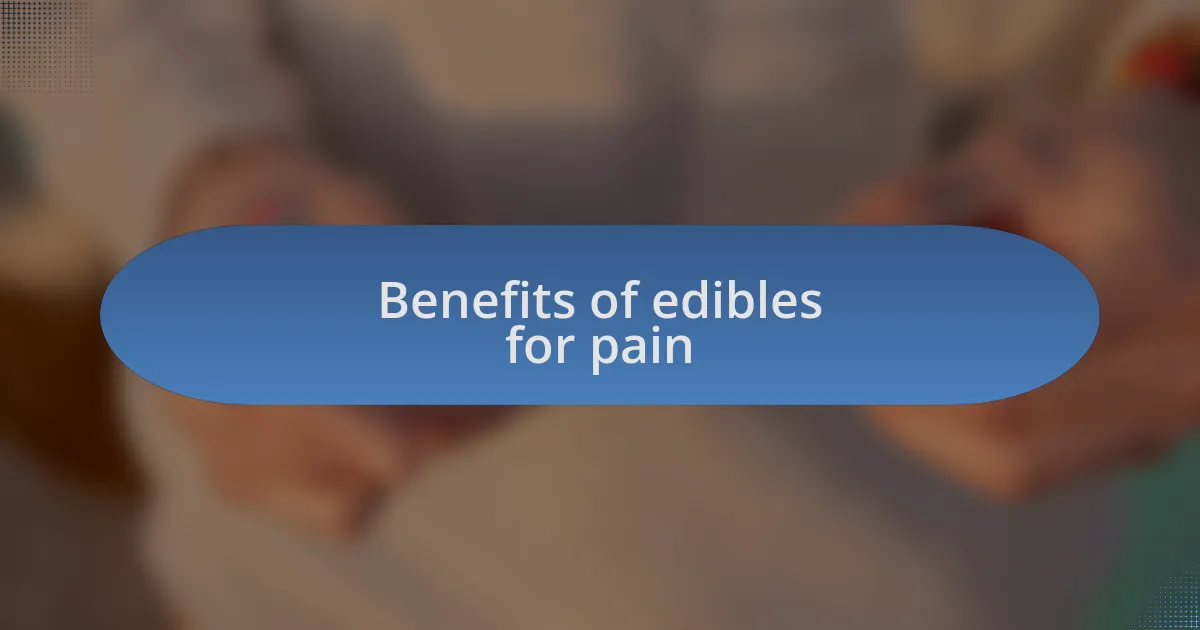
Benefits of edibles for pain
The benefits of edibles for pain management are truly remarkable. I recall a particularly tough day when my chronic pain flared up unexpectedly. I reached for a cannabis-infused chocolate bar, hoping for relief. As the pain subsided over the next couple of hours, I felt a sense of tranquility wash over me. It was like a warm embrace, easing tensions I hadn’t even realized I was holding.
Another significant advantage is the long-lasting effect of edibles. Unlike smoking, which often provides quick relief but wears off rapidly, edibles can sustain pain relief for several hours. I remember being able to enjoy a family gathering without the constant nagging of discomfort after trying a dose earlier in the day. It was a liberating experience to engage fully in the moment.
Moreover, edibles offer a discreet way to manage pain, something I appreciated when dining out with friends. I could carry a few gummies in my bag, and with just a small, inconspicuous dose, I found relief without drawing attention or altering the social atmosphere. Isn’t it comforting to know that pain relief can be as simple as enjoying a sweet treat, all while maintaining a sense of normalcy?
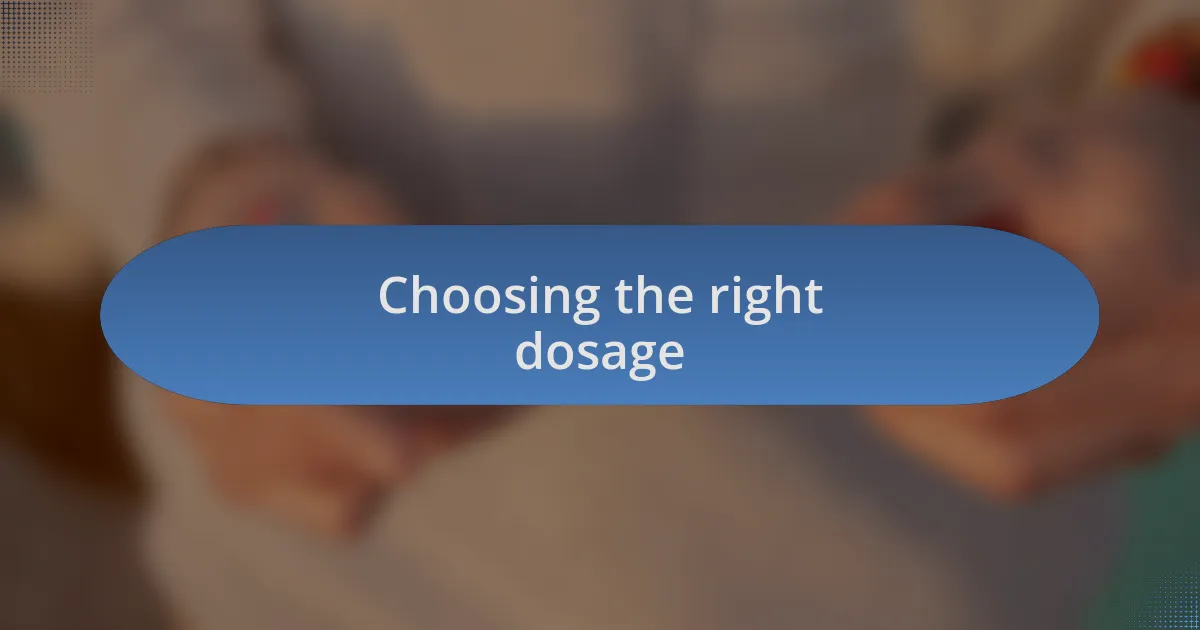
Choosing the right dosage
Choosing the right dosage of edibles can feel a bit like navigating a maze. I remember my first attempt; I took a dose that I thought was moderate based on recommendations, but it hit me harder than I expected. The experience taught me that everyone’s body reacts differently. How do you find that sweet spot? It often requires a bit of trial and error, which can be frustrating but ultimately rewarding.
Starting with a low dose is always a prudent strategy. I learned this the hard way when I felt overly sedated after overindulging in a batch of homemade brownies. I was left grappling with the effects longer than I would’ve liked. A friend of mine suggested that microdosing could be a better approach, and I started to take only half a gummy at first. This adjustment made me feel more in control of my relief, and I appreciated being able to maintain my usual daytime activities without a cloud of sedation hanging over me.
It’s essential to wait adequately before adjusting your dosage. After taking an edible, I always remind myself to give it at least 60 to 90 minutes to kick in fully. There was one time I was impatient and ended up taking another dose too soon, which led to an overwhelming experience. In hindsight, patience is key, and it’s like waiting for the right moment to enjoy a fine meal—you don’t want to rush it.
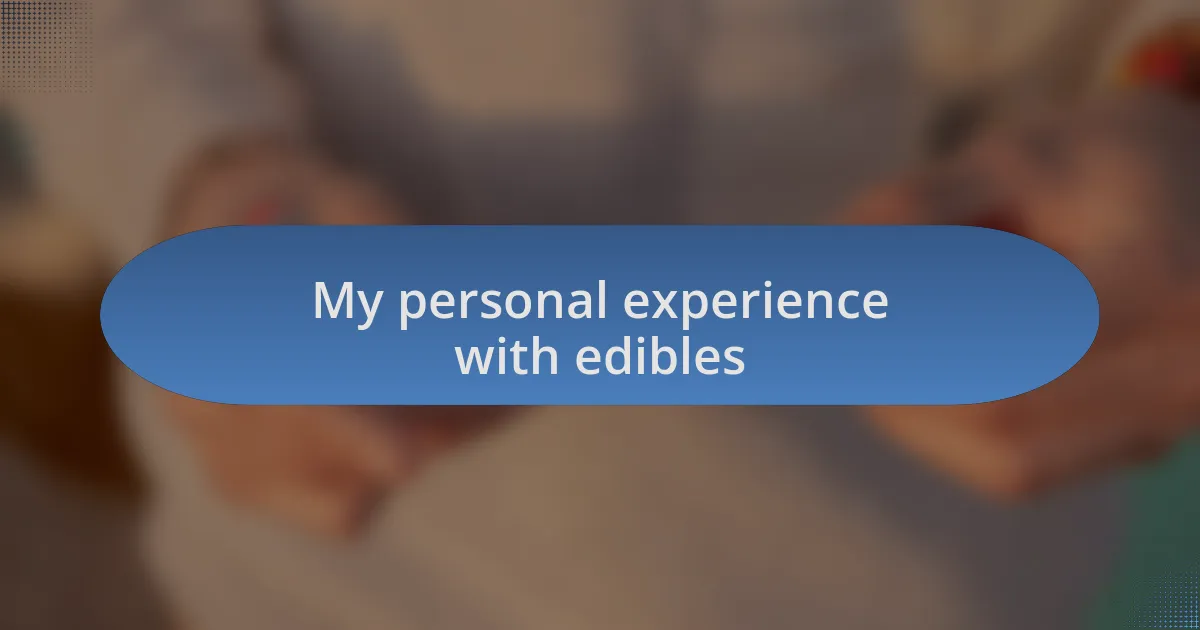
My personal experience with edibles
I remember the first time I tried edibles for pain relief. It was a rainy afternoon, and I was desperate for some comfort from my persistent discomfort. I opted for a chocolate bar, thinking it would be a treat while also doing the job. I took a small square and settled onto the couch, excited yet anxious. Little did I know, the wait would feel endless, and when the effects finally kicked in, it felt like a wave of warmth enveloped me. I was surprised by how soothing it was. It was a comforting relief that I had long sought.
As my journey continued, I had my share of trial and error. One experience stands out—a friend had gifted me some homemade gummies. I took one without much thought, and soon I started feeling a gentle buzz, which quickly escalated into something more disorienting. The world felt oddly vibrant, but I was also confused and slightly panicked. This taught me the importance of knowing my limits, a lesson that has stayed with me ever since. Have you ever felt that mix of excitement and dread from trying something new?
I truly believe that everyone’s experience with edibles is unique. On another occasion, I experimented with a different strain, seeking not just pain relief but also a mood boost. To my surprise, I felt a burst of creativity and energy, something I hadn’t anticipated. It made me wonder how many others might limit themselves out of fear of the unknown, missing out on potential benefits. What if your next experience could change how you view pain management entirely? It’s these personal insights and perspectives that shape my ongoing journey with edibles.
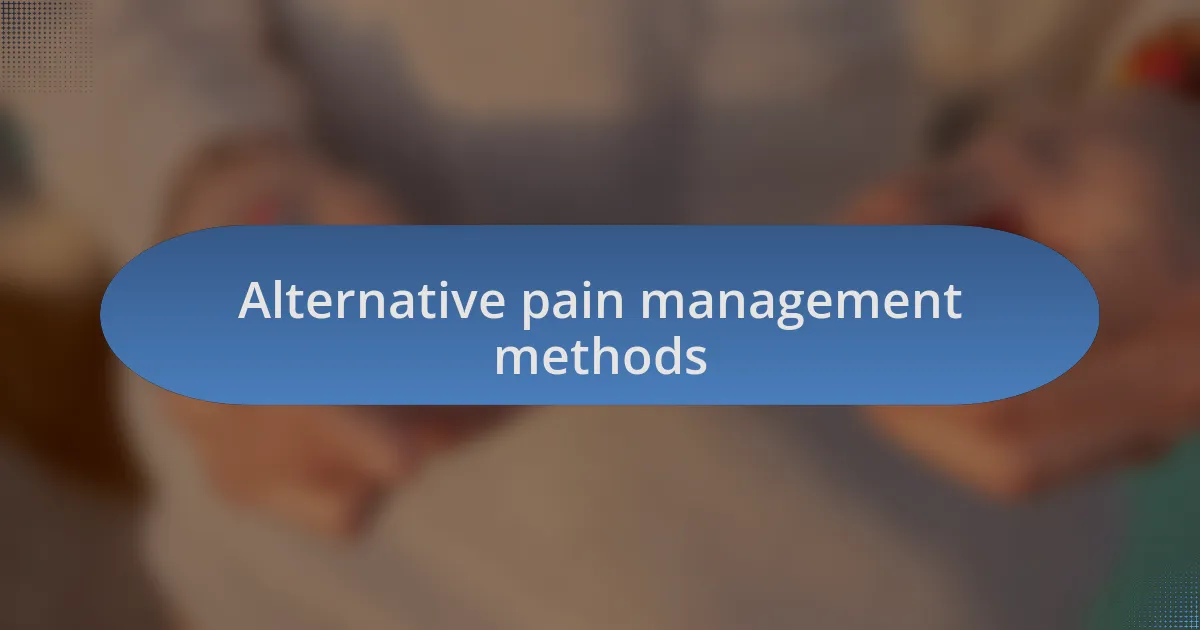
Alternative pain management methods
Alternative pain management methods can take many forms, and each option speaks to different experiences and needs. For instance, I once attended a workshop on mindfulness meditation, which at first seemed foreign to me. However, as I practiced deep breathing and focused on the present moment, I found that I could significantly reduce my pain perception. Have you ever tried to just pause and breathe?
Acupuncture is another intriguing alternative that I’ve tried. The first time I experienced those tiny needles, I was filled with skepticism. Surprisingly, after the session, I felt as if a heavy weight had been lifted off my shoulders. It made me realize that pain management is not solely about medication; it’s about exploring diverse approaches that can lead to relief.
Then there’s essential oil therapy, which I initially approached with caution. I remember blending peppermint and lavender oils and applying them during a particularly flare-up. The soothing aroma enveloped me, almost creating a protective bubble, and I began to feel a gradual sense of calm wash over me. It raises the question: what if something as simple as scent could play a role in your pain journey? Exploring these methods has opened my eyes to the many paths available for alleviating discomfort.
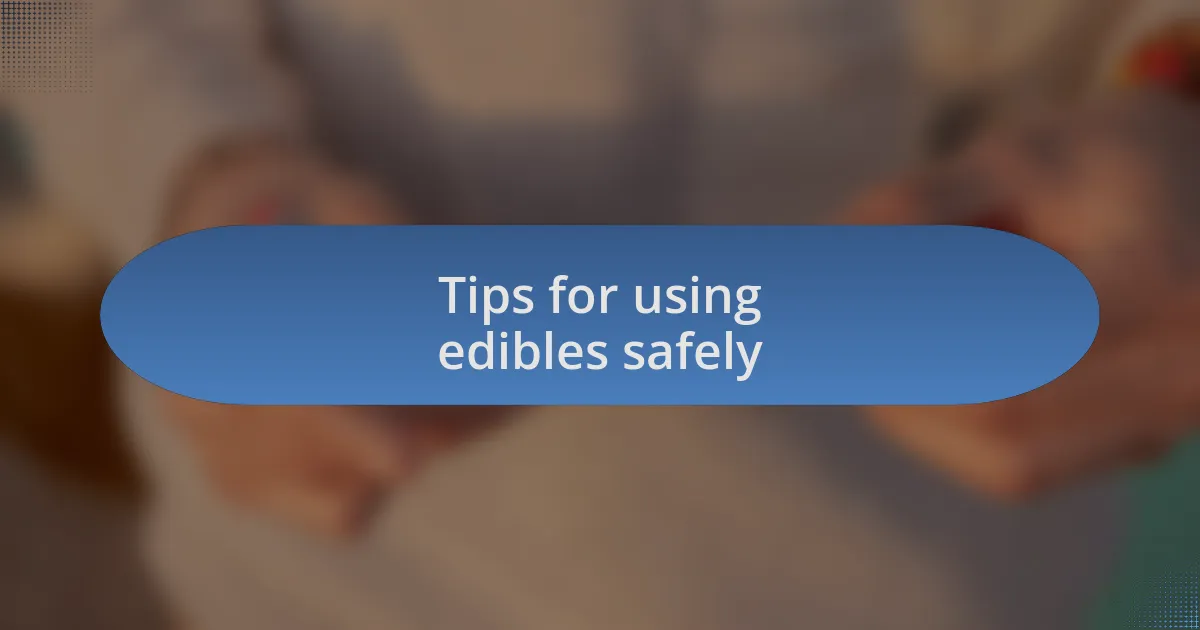
Tips for using edibles safely
When I first started using edibles for pain management, I quickly learned the importance of starting low and going slow. My initial dose felt overwhelming, and I was caught off guard by its potency. I now always recommend starting with a smaller dosage, allowing time to gauge how it affects me before considering an increase. Have you ever rushed into something only to regret it later?
Another key tip is to be mindful of the environment in which you consume edibles. The first time I tried them at a friend’s gathering was enlightening. With laughter and conversation swirling around me, I lost track of time and dosage, resulting in an overwhelming experience. Finding a calm, familiar space can enhance the experience and help you stay in control. What settings make you feel most comfortable?
Lastly, keeping a journal has become invaluable for tracking my experiences with edibles. Each time I take them, I jot down the dosage, the type of edible, and how I felt afterward. This practice not only provides clarity but also helps me understand what works best for my pain management. Have you considered documenting your experiences to refine your approach?